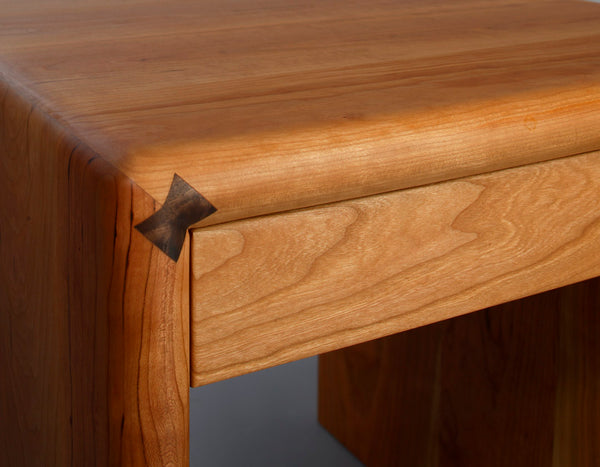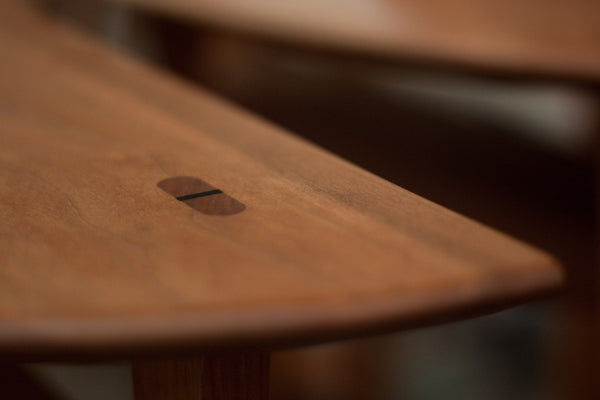Our furniture is made in the tradition of some of the finest furniture ever created. We use time-honored joinery techniques and top quality hardwoods. Below are a few brief explanations of some of the joinery we incorporate in our furniture. These methods are what allow us to place a lifetime warranty on it.

DOVETAILS:
There are many types of dovetails. The term is derived from the shape of the male part of the joint; the part that looks like a doves tail. We use half blind dovetails, blind dovetails, through dovetails, sliding dovetails, and butterfly dovetails.
We use through dovetails, where you can see the joint from both sides at a corner in some of our pedestals.
Our drawers use half blind dovetails on their four corners. These dovetails are only visible on one side of the joint. These joints and the 3/8"th hardwood plywood drawer bottoms set into a dado, give our drawers tremendous strength.
This is not a trick, and the case has not been modified in any way from our usual construction methods. It is a series of well executed joints working in tandem, like it should be.

SLIDING DOVETAIL:
Sliding dovetails are used extensively in our case goods. What we refer to as "blades", the bars that are between drawers, are dovetailed and set into a rout. This makes an extremely strong connection. In larger applications, we rout fixed shelves into cases in the same manner.
One of our trademark dovetails used is a butterfly dovetail on the corner of our Platform Pedestal Bed. We also use it on other furniture. The corner is mitered and then routed with 2 dovetail routs, and a corresponding dovetail "spline" or key is made to connect the two halves.

Mortise and tenon
As with many of the classic joints, there are many variations of the mortise and tenon joint. Two of these are standard for us. The through mortise is where the cut goes all the way through the part, as in our Shinto Stools. In the case of our Shinto Stools, we wedge the tenon with an Ebony wood accent.
The other mortise is a blind mortise. The cut goes only part the way through the part, as in our dining chairs. The joint can then be pegged, driving a dowel pin through both the mortise and tenon together for added strength.
Lock Miter
The lock miter is a modern take on an old, hand-cut joint, and later, a joint cut on a table saw in a series of cuts. The joint is specific to joining end grains of solid wood. We use the lock miter in all sorts of applications where the clean attachment of two solid wood panels comes together at a corner. Our Contemporary and Waterfall Collections use the lock miter joint extensively.
Sign up to get the latest on sales, new releases and more …
VIRGINIA - CULPEPER
(Near Culpeper Airport)
21405 Business Ct.
Elkwood, VA 22718
Phone: (540) 423-3060
Email: info[at]hardwoodartisans.com
Hours:
Monday - Saturday: 9 AM - 4 PM
Sunday: Closed
VIRGINIA - ARLINGTON
(The Village at Shirlington)
2800 S. Randolph Street
Arlington, VA 22206
Phone: (703) 379-7299
Hours:
Monday - Saturday: 10 AM - 8 PM
Sunday: 12 PM - 5 PM
VIRGINIA - CHARLOTTESVILLE
(The Shops At Stonefield)
2075 Bond Street, Suite 150
Charlottesville, VA 22901
Phone: (434) 284-7656
Hours:
Monday - Saturday: 10 AM - 8 PM
Sunday: 12 PM - 5 PM
MARYLAND - BETHESDA
(Woodmont Triangle)
4828 St. Elmo Ave.
Bethesda, MD 20814
Phone: (240) 483-0250
Hours:
Monday - Saturday: 10 AM - 7 PM
Sunday: 12 PM - 5 PM
© 2024 Hardwood Artisans
